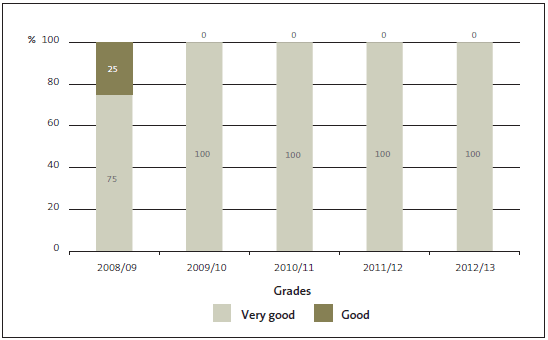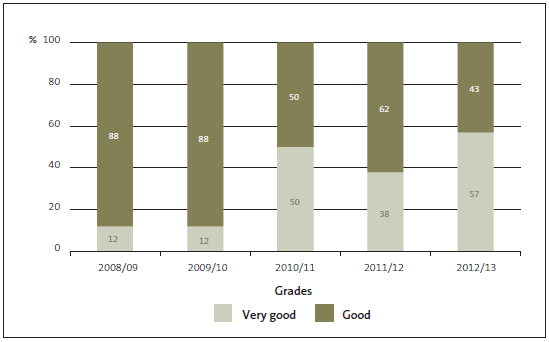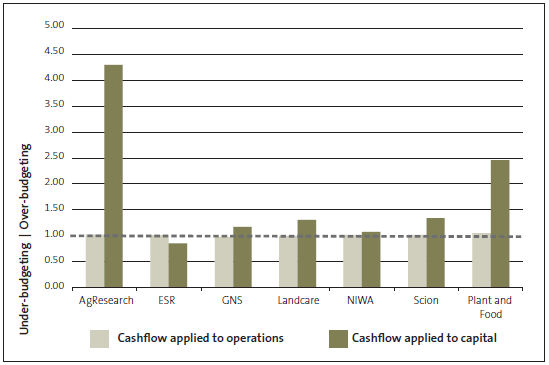Part 6: Crown research institutes' audit results
6.1
In this Part, we report on the results of our audits of CRIs for 2012/13. We set out our assessments of their management control environments and financial information systems, particular observations from the audits, and discuss the financial performance of CRIs.
About Crown research institutes
6.2
The seven CRIs were established under the Crown Research Institutes Act 1992 to carry out research for the benefit of New Zealand. The CRIs also provide a range of scientific and advisory services.
6.3
The CRIs are:
- AgResearch Limited (AgResearch);
- Institute of Environmental Science and Research Limited (ESR);
- Institute of Geological and Nuclear Sciences Limited (GNS);
- Landcare Research (New Zealand) Limited (Landcare);
- National Institute of Water and Atmospheric Research Limited (NIWA);
- New Zealand Institute for Plant and Food Research Limited (Plant and Food); and
- New Zealand Forest Research Institute Limited (Scion).
6.4
We also audited Callaghan Innovation Research Limited (CIRL). CIRL is now a subsidiary company of a new Crown entity, Callaghan Innovation. CIRL used to be called Industrial Research Limited, and it was the eighth CRI before it was absorbed into Callaghan Innovation on 1 February 2013.
6.5
For the year ended 30 June 2013, the seven CRIs and CIRL reported combined total revenue of about $710 million (2011/12: about $707 million) and total assets of just over $738 million (2011/12: $733 million). The aggregate equity of the seven CRIs and CIRL was just over $547 million (2011/12: just under $527 million).16 Together, the seven CRIs employed about 3500 full-time equivalent staff.17
Audit reports for 2012/13
6.6
We issued standard audit reports for all seven CRIs for the year ended 30 June 2013. We also issued a standard audit report for CIRL.
Environment, systems, and controls
6.7
We again assessed the systems and controls of CRIs as being of a high standard.
6.8
As part of the annual audits, our auditors assess and grade the management control environment of CRIs and their financial (but not their service performance) information systems and controls.18 We report our assessments of each CRI to its management and board, the Minister of Science and Innovation, the Ministry of Business, Innovation and Employment (as the monitoring department), and the Treasury.
6.9
In 2012/13, we graded all seven CRIs as having "Very good" management control environments. This is consistent with the grades we issued in the preceding three years.
6.10
We graded all seven as either "Good" (three) or "Very good" (four) for financial information systems and controls. A "Very good" grade means that the appointed auditor did not recommend any improvements. A "Good" grade indicates that we do not have any significant concerns but that the appointed auditor recommended some improvements.
6.11
This is an improvement on 2011/12, when four were rated "Good" and three were rated "Very good".
6.12
These results compare well with the results for other groups within the central government sector (see Parts 4 and 5).
6.13
Figures 17 and 18 summarise the last five years' assessments.
Figure 17
Crown research institutes – grades for management control environment, 2008/09 to 2012/13

Figure 18
Crown research institutes – grades for financial information systems and controls, 2008/09 to 2012/13

Observations and matters arising from the audits
6.14
In our reports on our audit work with CRIs in 2012/13, we made the following observations or raised the following matters.
Restructuring and business transformations
6.15
We noted that there were a number of significant business and organisational changes under way:
- AgResearch will be undergoing significant restructuring with its Future Footprints project.
- Landcare restructured its subsidiaries on 1 July 2013 to improve its financial performance.
- Scion sold its software brand, ATLAS Technology, on 1 January 2014.
- ESR's core laboratory operating systems have been replaced.
- There has been a review of Plant and Food (the first of the four-year rolling reviews of the CRIs), which could affect the way the CRI carries out its business.
Performance reporting
6.16
We do not audit or grade the performance reporting of CRIs. However, we indicated in our report on CRIs in 201319 that we had a particular interest in the reporting of performance against the statement of core purpose. Improvements to service performance reporting were suggested for AgResearch and GNS in our reports on their 2012/13 audits. We intend to report further on this topic after the 2013/14 audits of the CRIs.
Valuation of heritage assets
6.17
We again noted the ongoing issue with CRIs in valuing heritage assets. Because of their nature, it is not easy to reliably place a value on heritage assets. Such assets are usually irreplaceable, and a value is therefore difficult to assess.
Financial results for 2012/13
6.18
The aggregate net profits of the seven CRIs and CIRL20 showed a 29% decline from $21.5 million (in 2011/12) to $15.3 million (in 2012/13). All CRIs made a profit, of between 0.6% and 5.7% of their revenue. CIRL made a loss of $1.9 million.
6.19
Most CRIs retained these profits within their businesses rather than making a return to the shareholder.
6.20
Two CRIs provided a dividend to shareholders for 2012/13: GNS ($0.25 million) and NIWA ($2 million). The latter was declared after the balance date.
6.21
Figure 19 shows the CRIs' and CIRL's group financial results for 2012/13, comparative results for 2011/12, and retained earnings for 2012/13.
Figure 19
Financial results for Crown research institutes and Callaghan Innovation Research Limited, 2011/12 and 2012/13
| CRI | Revenue | Net profit(loss) | Retained earnings | |||
|---|---|---|---|---|---|---|
| 2012/13 $million |
2011/12 $million |
2012/13 $million |
% of revenue | 2011/12 $million |
2012/13 $million |
|
| AgResearch | 162.9 | 157.8 | 5.7 | 3.5 | 4.2 | 5.7 |
| ESR | 62.3 | 58.8 | 1.3 | 2.0 | 2.4 | 1.3 |
| GNS | 72.2 | 74.9 | 1.1 | 1.6 | 4.0 | 1.1 |
| IRL/CIRL | 70.1 | 68.3 | (1.9) | (2.7) | 1.2 | N/A |
| Landcare | 55.6 | 59.3 | 0.6 | 1.1 | 1.3 | 0.6 |
| NIWA | 120.8 | 121.4 | 4.6 | 3.8 | 5.5 | 4.6 |
| Plant and Food | 120.4 | 122.3 | 2.2 | 1.9 | 1.3 | 2.2 |
| Scion | 45.6 | 44.1 | 1.7 | 3.7 | 1.6 | 1.7 |
| Total | 709.9 | 706.9 | 15.3 | 21.5 | ||
Note: All results have been rounded to one decimal place, and have then been totalled. Revenue figures have been adjusted where necessary so that the treatment of "other gains and losses" and finance income is consistent.
Analysis of the financial statements
6.22
In Part 7, we present our analysis of the audited financial statements of central government entities, and contrast the financial health of government departments, CRIs, and most other Crown entities. The following summarises the findings for CRIs and provides some more detail.
Ability to operate as planned
6.23
In terms of their ability to operate as planned, we found that, comparatively, CRIs as a group are at low risk of over-forecasting or under-forecasting their operational spending needs. However, as with the other central government entities, there is a high risk that they will over-budget (or under-spend) on capital assets.
6.24
We looked in detail at CRIs' audited financial statements for 2012/13.21, 22 Figure 20 shows that, in four of the CRIs, actual spending varied by more than 20% from the budgeted capital amount. The most variance was in AgResearch (330%) and Plant and Food (145%).
Figure 20
Ratio of Crown research institutes' budget to actual spending, for 2012/13

6.25
This trend of the capital budget being higher than actual spending has been consistent in the last six years, and is common to other Crown entities.23 To see whether this trend extended beyond the parent company, we also looked at the financial statements of one material CRI subsidiary and found the opposite of the parent company's trend. That is, during the last three years, the subsidiary consistently spent considerably more on both operations and capital than its budget.
6.26
We intend to carry out further analysis in 2014/15 to understand better the relationship between planned and actual spending by the CRIs.
Ability to manage uncertainty
6.27
As a sector, CRIs are at low risk of being unable to cover their current liabilities with current assets, if needed. However, the nature of their activities means that ongoing or fixed costs are moderately high and the ability to adjust and adapt in times of change could be limited. We do not consider this represents a high risk in CRIs as a group.
Ability to invest for the future
6.28
None of the CRIs currently have ratios of liabilities to assets that suggest the level of liabilities could adversely affect their ability to invest for the future.
6.29
However, the two CRIs that are under-spending their capital expenditure budget have, on average, been spending less on assets in the last three years than the level of depreciation and amortisation, that is below what accounting judgements would suggest is reasonable for the long term. If this level of capital spending were to continue, it could begin to adversely affect the sustainability of services.
Our focus
6.30
We will continue our interest in whether CRIs' reporting against their statements of core purpose meets the relevant reporting requirements. We will also continue to include, in our reporting, the results of our analyses of the financial performance of CRIs.
6.31
We have recently reported on Maintaining a future focus in governing Crown-owned companies (February 2014). CRIs were included in the study. Among other matters, we found that Crown-owned companies that innovate and communicate to a wide range of stakeholders are more likely to be preparing well for the future. We saw evidence of:
- better asset planning and condition than in the rest of the state sector;
- longer-term thinking, such as Scion extending wood-processing technology to help sewage disposal; and
- increases in Crown-owned companies' financial resources, allowing them to better manage uncertainty or invest in the future.
6.32
Future audit work will focus, within CRIs and other public entities, on:
- the level of deferred maintenance and capital expenditure;
- the nature and status of asset management plans, and the extent to which entities are delivering on their asset management plans; and
- governance and accountability, including audit and risk at the governance level.
16: According to data from the audited financial statements of the CRIs and CIRL.
17: According to annual reports and figures provided by the Ministry of Business, Innovation and Employment.
18: Industrial Research Limited is included in the Figure 17 and Figure 18 graphs for 2008/09 to 2011/12. CIRL, as a subsidiary company, was not graded.
19: Controller and Auditor-General (2013), Crown Research Institutes: Results of the 2011/12 audits, Part 4, Wellington.
20: The results for IRL (later CIRL) have been included for comparative purposes.
21: We did not include CIRL in this section because its budget figures for 2012/13 were not available.
22: We used parent data for this financial analysis and, where parent budget data was unavailable, we used pro-rated group budgets. Doing so lets us separately analyse the interactions of larger subsidiaries with the parent.
23: See paragraphs 7.14 and 7.15 for a discussion of possible reasons for this. See also our 2013 report, Crown Research Institutes: Results of the 2011/12 audits.
page top
